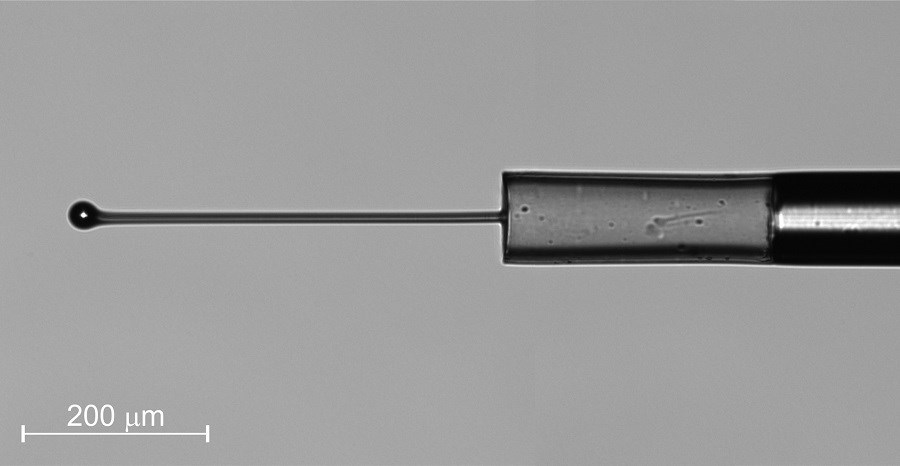Sep 9 2020
A tiny yet complex fiber optic force sensor developed by scientists can quantify very mild forces exerted by tiny objects.
 Researchers developed a tiny fiber optic force sensor that can measure extremely slight forces exerted by small objects. It can be immersed in a variety of liquids and doesn’t need any additional packaging for most applications. Image Credit: Denis Donlagic, University of Maribor.
Researchers developed a tiny fiber optic force sensor that can measure extremely slight forces exerted by small objects. It can be immersed in a variety of liquids and doesn’t need any additional packaging for most applications. Image Credit: Denis Donlagic, University of Maribor.
The novel light-based sensor resolves the restrictions of force sensors built on micro-electro-mechanical sensors (MEMS) and may prove handy for applications ranging from manufacturing to medical systems.
Applications for force sensing are numerous, but there is a lack of thoroughly miniature and versatile force sensors that can perform force measurements on small objects. Our sensor helps meet this need as one of the smallest and most versatile optical-fiber force sensors designed thus far.
Denis Donlagic, Study Team Leader, University of Maribor
Donlagic and Simon Pevec have explained their new light-based sensor in Optics Letters—a journal of The Optical Society (OSA).
The sensor is made of silica glass developed into a cylinder that measures only 800 µm in length and 100 µm in diameter—about the same thickness as that of a strand of human hair.
To demonstrate the potential of the new sensor to quantify force with a resolution better than a micronewton, the researchers used this device to quantify the surface tension of a liquid or the stiffness of a dandelion seed.
The high resolution force sensing and broad measuring range could be used for sensitive manipulation and machining of small objects, surface tension measurements on very small volumes of liquid, and manipulating or examining the mechanical properties of biological samples on the cellular level.
Denis Donlagic, Study Team Leader, University of Maribor
Creating an All-Glass Sensor
While miniature force sensing capabilities can be provided by MEMS-based sensors, the applications of these devices are rather limited. This is because such sensors need multiple electrical connections and protective packaging that are specific to certain applications. Moreover, without adequate packaging, MEMS devices are not biocompatible and cannot be submerged in water.
Therefore, to create a more multipurpose, miniature force sensor, the researchers developed an all-optical fiber optic sensor that is fully made of glass. The team performed this complex task by using a unique etching procedure that was earlier developed by them to produce intricate all-fiber microstructures.
This micromachining process was used to develop a sensor based on a Fabry-Perot interferometer, which is an optical cavity produced from a couple of parallel reflecting surfaces.
The researchers created the miniature interferometer by using the end of the sensor’s lead-in fiber along with a thin, flexible silica diaphragm. When they applied an external force onto a silica post with either a cylindrical or round force-sensing probe on the end, they observed that this force alters the length of the interferometer in a way that can be quantified with subnanometer resolution.
The way the structures of the new sensor were created resulted in an air-sealed cavity that is guarded from contamination and is conducive for use in biochemical settings.
The novel sensor can be submerged in a wide range of liquids, and it can also quantify negative and positive forces. Moreover, it does not require any further packaging for a majority of the applications.
Measuring Tiny Forces
Once the researchers assessed and calibrated the sensor, they used it to quantify the Young modulus—a measure of stiffness—of common dandelion seed and a human hair.
The researchers also quantified the surface tension of a liquid by determining the retraction force when a tiny cylinder was taken off from a liquid. They were able to quantify force with a force range of around 0.6 mN and a resolution of around 0.6 µN.
The force sensing tip can be made substantially smaller—down to about 10 microns in diameter—and can be adapted to perform various force sensing tasks. The miniature force sensor can also be used to create more complex sensors such as sensors that measure magnetic and electric fields or determine the surface tension or flow of a liquid.
Denis Donlagic, Study Team Leader, University of Maribor
According to the team, the present version of the new sensor is set for use. But creating probe tips with other kinds of shapes, enhancing the overload robustness, or introducing miniaturized packaging could additionally extend potential applications.
To make the new sensor more practical, the team is also working to automate the procedures used to design this device.
Journal Reference:
Pevec, S & Donlagic D (2020) Miniature all-fiber force sensor. Optics Letters. doi.org/10.1364/OL.401690.
Source: https://www.osa.org/